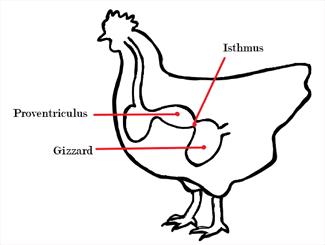Avian Stomach

Illustration by Shalini Radhakrishnan/VIN
Avian gastric yeast infection is a bird disease caused by a yeast, Macrorhabdus sp, that causes gastrointestinal problems. It is highly contagious and affects a variety of birds. An older name for it is megabacteria because of its size. The organism infects the bird’s stomach, and the infection destroys the ability of the bird’s stomach to properly digest and absorb nutrients from food.
Avian Stomach Anatomy
The avian stomach is quite unlike the human one and has two parts with a connector. The proventriculus digests food; the isthmus moves food between the proventriculus and the gizzard; and the gizzard grinds food for easier digestion. Food moves back and forth between the proventriculus and gizzard until it is fully digested and the nutrients are absorbed.
Who gets Avian Gastric Yeast?
This disease occurs in a wide range of birds, such as chickens, partridges, ostriches, turkeys, parrots, finches, and budgerigars. Being infected with avian gastric yeast does not always result in infection and subsequent disease.
- Species: Budgerigars are most common
- Gender: No predisposition
- Age: Mature birds more commonly affected (2-3 years)
- Cause: Contact with infected bird
- Transmission: Fecal oral
- Predisposing factors: Poor housing management, stress, genetics
Signs
Signs of avian gastric yeast infection and disease are nonspecific and can take on two forms: acute and chronic.
- Acute: the bird stops eating, has bloody regurgitation, and dies within 2 days
- Chronic: the bird is emaciated, weak, regurgitates food, has undigested seed in droppings, diarrhea, continues to eat, loses weight, and finally dies.
Diagnosis
As avian gastric yeast is transmitted through the fecal to oral route, fresh fecal samples are used as a quick diagnostic tool.
Fecal tests are not highly accurate as the organism is shed sporadically in droppings. A negative test does not rule out infection.
- Cytology - microscope is used to look for the organism in the droppings. The organisms can be stained by the acid-fast [AFB] method.
- PCR test - more accurate but expensive and time consuming
Histology, a sample of the tissue, is the only definitive test for avian gastric yeast infection. An isthmus tissue sample is usually done after death because of the complication and risk of a surgical procedure.
Treatment
Treatment outcome varies depending on the severity of the clinical signs the bird is experiencing.
- Amphotericin B is an antifungal
- Fluconazole is another antifungal used when amphotericin B does not work.
Prevention
There is no vaccine to prevent avian gastric yeast. The only way to prevent the infection from spreading is clearing it from your flock. Quarantine all new birds for 30 days before introducing them to the flock. A veterinary exam is a necessity for all new birds.